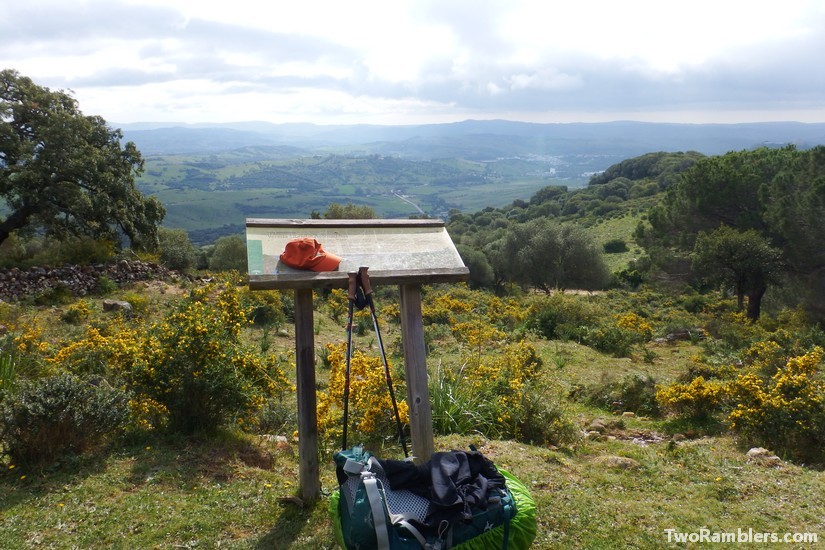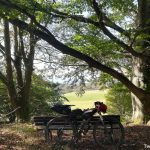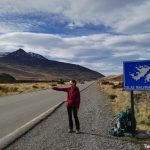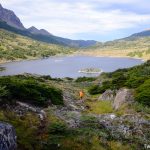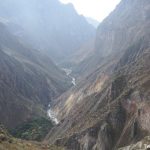Part I: Taraguilla to Ronda
Andalucía – the word brings to mind images of Mediterranean beaches and Moorish architecture under a hot, burning summer sun. When visiting a friend in Málaga in March 2019 we had some doubts if we should pack our hiking shoes, if Andalucía was hiding some worthwhile hiking routes. In our favourite travel book store we came upon a book called ‘The Andalusian Coast to Coast Walk’. We decided to give it a try, selecting a promising part along three national parks for nine days of hiking in two parts.
We chose to start the hike in Taraguilla, an easy drop off point, and walk north to Ronda, passing the east side of the Parque Natural Los Alcornocales and the Parque Natural de la Sierra de Grazalema. After a break back at the coast we then walked from El Chorro, through the northern part of the Parque Natural Sierra de las Nieves. This second part ended once again in Ronda, this time coming in from the east.
Day 1: Taraguilla to Castillo the Castellar – storks and butterflies
We were eager to start our hike to leave behind the smell of cold cigarette smoke of our motel room and the industrial air of Taraguilla. However, there was an unspoken doubt between us: Would we enjoy what lay ahead of us? During the few days we had spent in Málaga and its surroundings we had seen endless rows of holiday apartments, dry nature and very little green.
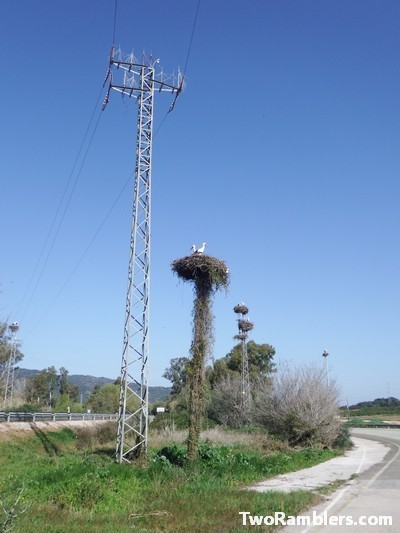
For the first part of the day, the route was not very interesting. We had to follow a seemingly endless cycling path next to a busy road and had to look out not to be run over by the many cycling tourists. We were cheered up by the storks around us: nesting on utility poles, trees or whatever they could find, standing still, alone in the fields or circling in the sky above us, filling the air with clicking sounds. At some point we had more than 100 of them within our view.
We had our lunch in Almoraima. Then, we continued on what looked again like a long stretch on the road, this time without a cycling path to separate us from the cars. After 15 minutes, we decided to turn around and search for a nicer route. The map on our phone showed a promising alternative. Best decision of the day! Taking the dirt road next to the Venta La Cantina, a restaurant busy with local tourists, we found the Sendero de la Mariposa Monarca. The small path along the rio Cuadaranque seemed like a little paradise. The ground was full of yellow flowers, there were butterflies in the air and the bubbling brook next to us. The eucalyptus trees around us gave a nice smell to the air and shade from the hot sun. We even got a glimpse of a Monarch butterfly.
Near the end of the path we started to look for a place to put our tent but could not find a quiet spot with the many tourists around. So, we continued our route uphill on an old Roman road running toward Castillo de Castellar. In the middle of the hill we found a spot, not perfect but good enough for our tent: quiet, green and with a view.
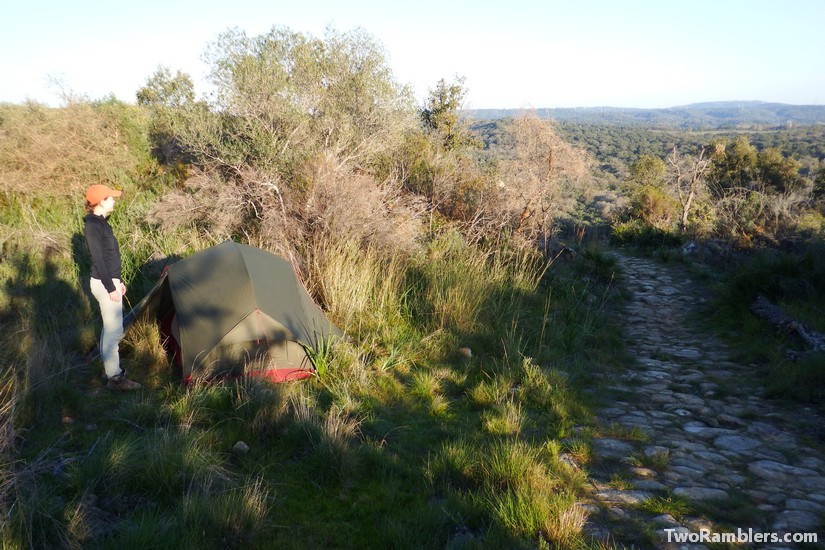
Day 2: Castillo the Castellar to Jimena de la Frontera – castles and farms
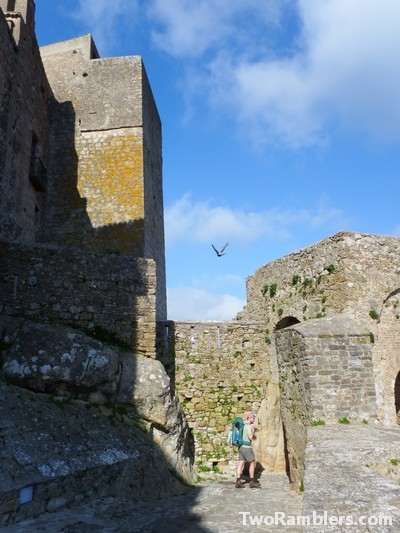
The next morning, we continued up the old Roman road. We had breakfast inside the walls of Castillo de Castellar, impressed by this village built on a big rock. After exploring it and buying fresh bread we were ready for the next stage. The first half of the day was mainly downhill on a road with small patches of dry forest around us. After two hours the landscape changed to dry, flat fields with abandoned farmhouses interrupted by a few fields of impressively lush, green grass.
We reached a railroad track that we had to follow until Jimena de la Frontera. This was a very long, monotone walk. On one side the railroad tracks were slightly elevated and blocked our view. To the other side were wet fields with farmers preparing their irrigation systems for the summer. A little relieve from the heat came in form of small pieces of Eucalyptus forest. Jimena de la Frontera started rising in front of us, with its castle on top of a hill. The walk up into town felt hard in our legs but knowing that we would not find a quiet spot to camp in this town it was the idea of a hot shower that kept us going. The town was beautiful to look at but exhausting to walk through, tiny streets, a sort of labyrinth, steep up and down hill. We found a camping site on the other end of the town where we had our anticipated shower.
Day 3: Jimena de la Frontera to El Colmenar – a wild cat, deer and owls
The next day started with a climb up a steep hill on what appeared to be a Roman road again. At the end of the road we continued on wild patches of overgrown paths, alternating with forest roads through a cork tree wood. The higher we got, the rockier and sandier were our surroundings. Near the top of the hill, we could take a look back to the coast with an amazing view of the Strait of Gibraltar.
The second part of that day’s hike was slowly downhill. The dry corky land started to make way for greener patches of field and ruins of farms. Walking a little ahead as usually Kevin spotted some movement: “Did you see that big cat?” It might have been an Iberian lynx.
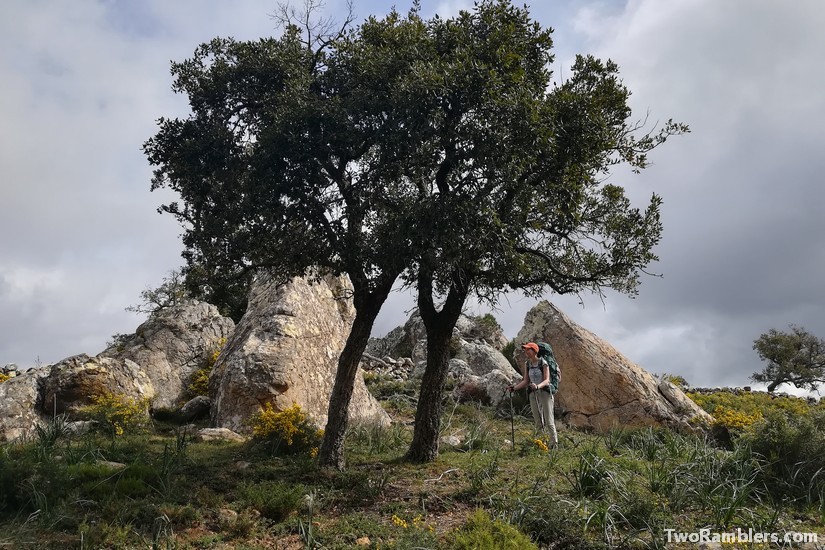
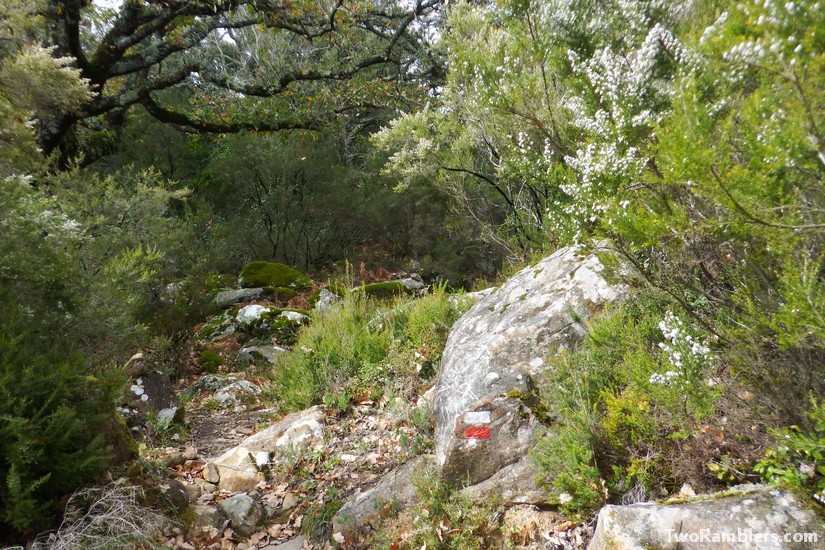
The landscape changed and we were walking through thicker forests of old oak trees along streams. There were even liana hanging from trees. We saw two deer crossing the path in front of us. We continued slowly as the way was overgrown and not always clear. After walking for another while we found an open spot under some old oak trees next to a small stream – ideal for camping! It looked like it used to be old meadows with stone fences that were fallen down and swallowed by the land over time. We had the feeling of being in a Tolkien story. We put our tent up in the setting sun and had dinner under the watchful eyes of two owls in the old oak trees around us. The owls seemed to be attracted to Kevin’s imitation of their screams but we moved into our tent before they got too close.
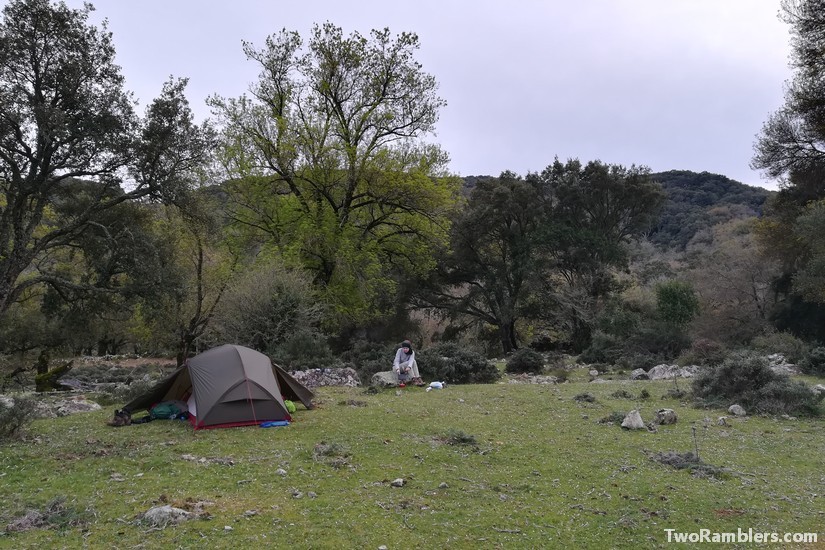
Day 4: El Colmenar to Cortes de la Frontera – a lot of rain and drunk locals
We were on our feet at the break of dawn as there was a lot of rain predicted for later that day. We made good speed towards El Colmenar. After leaving the magical camping area, we walked mainly on small forest tracks trough cork forests. We reached El Colmenar before noon, just in time as the first drizzle was settling in. As the rain became heavier, the sky covered in dark clouds, we decided to skip hiking for the day and took a bus to Cortes de la Frontera. We would have liked to take the train as it takes the same route as our hiking trail. However, the railroad was under construction. Leaving El Colmenar we had mixed feelings. On the one hand, we were glad we did not have to walk in the heavy rains – the bus driver had difficulties seeing the street ahead – and that we had left El Colmenar where all locals had seemed drunk. On the other, we were also skipping a supposedly beautiful hike through the Guadiaro valley because the bus did not follow the same route as the train.
The bus dropped us off at the closed train station of Cortes de la Frontera. We had lunch under the big roof of the platform and waited for some holes in the sky to hike the last four kilometers uphill to the town of Cortes de la Frontera. We made some unconvincing attempts to hitchhike but finally took the chance of a break in the rain to start the uphill walk. Half way through a winding, sandy path the rain came back in full force with no cover possible. In no time we were completely soaked. Ten minutes later the sun was out again and we reached the town. We found a cosy holiday apartment to cook a hot dinner and dry our clothes.
Day 5: Cortes de la Frontera to Montejaque – cows, sheep, horses and dogs
The next morning the rain had stopped but it had become much colder compared to the previous mornings. We left town and started to climb up into the mountains north of us. It was a beautiful walk between the rocks with a lot of different herbs around. After a good hour we reached a valley with karst limestone around us and some impressively old oaks. In our guide book we read that these can be up to 500 years old.
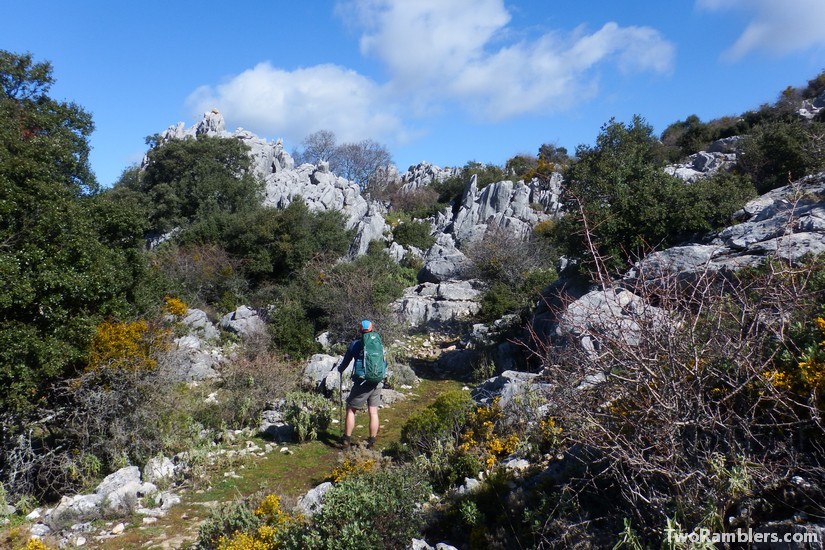
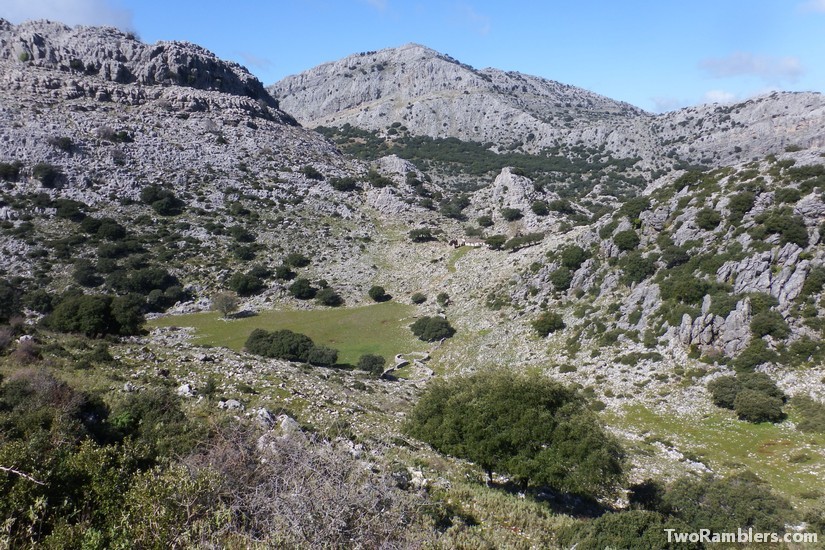
We walked through a farm with hundreds of sheep and cows grazing around freely with here and there a horse. As we passed the farm houses we saw the farmer with his dogs. Our guide book said something about the farmer not being too happy about hikers passing through his fields. So we were not quite sure whether his waive was welcoming or rather telling us to leave. We were relieved when we finally climbed over a gate and left his land and the barking dogs behind us.
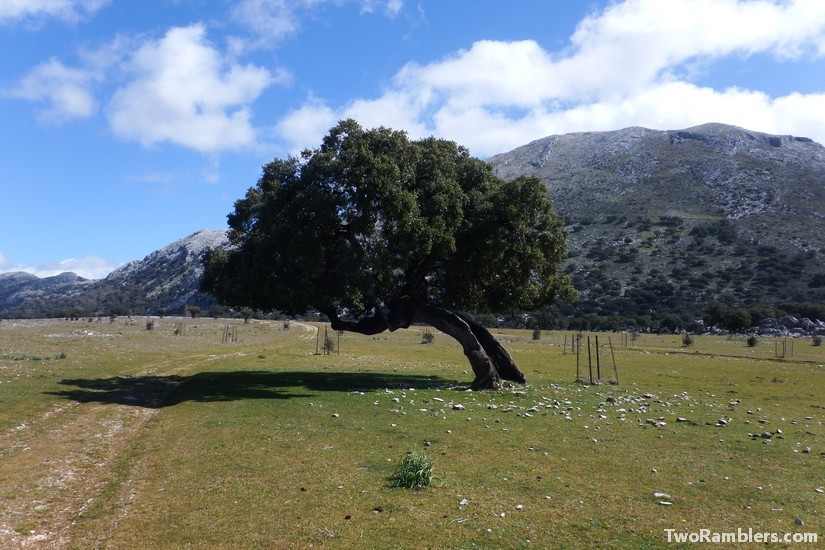
The route continued through a landscape that again made us think of Middle Earth. The sun being out made the walk even better. We had lunch at a closed hostel and for the first time in four days met some other hikers on our route. On the way to our next stop, Montejaque, we passed a bunch of small gardens and cages with barking dogs – not very welcoming. But Montejaque turns out to be a cosy town with those typical white houses. We spent the night comfortably in a hotel at the main square.
Day 6: Montejaque to Ronda – tourists
Our enthusiasm to start on our last day for this part of the hike got immediately pushed back. We found ourselves locked in in our hotel. It took us a while to explain over the phone to the owners of the hotel that our key did not work and even longer for them to send someone to let us out.
Our walk led us uphill to a small church with a green yard. It would have been an ideal camping spot and would have saved us a lot of trouble at the hotel. But that is the perk of hiking. Even with a good map it is always a guess whether a spot will be flat and quiet enough to put up a tent.
The rest of the day, we walked through fields and passed more and more houses as we got closer to Ronda. After a small patch of pine forest, we got the first view of Ronda, its cliffs and of course the famous Puente Nuevo over the great gorge. We hiked up a small road east of the bridge and entered Ronda via Plaza Maria Auxiliadora. The many tourists around us were a big contrast to the previous days in the solitude of nature. We found a hotel to spend the night and explored the city and its carnival celebrations.
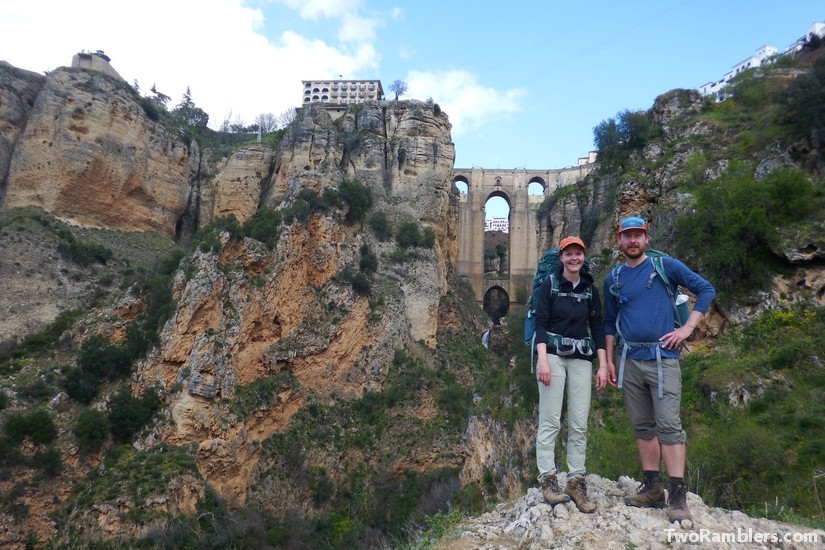
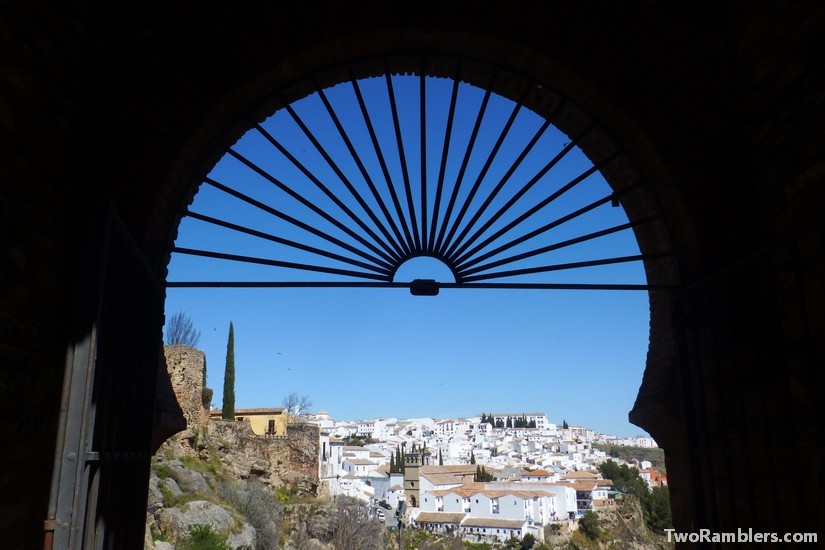
The following day we met up with our friend from Málaga. By car we explored the town of Setenil de las Bodegas known for its white houses built deep into the cliffs around the rio Trejo.
Part II: El Chorro to Ronda
After a weekend in Málaga we decided to do some more hiking in Andalucia on another piece of the ‘Coast to Coast Walk’. We took the train to El Chorro and walked in the direction of Ronda. This time we walked without our tent and sleeping bags because the stages were going to be long. Also, based on the maps, we had doubts if we would pass any camping spots.
Day 7: El Chorro to Carratraca – vultures and caterpillars
After a short train ride, we arrived in El Chorro, a sleepy village except for a few climbers wandering around. The town is apparently a well-known place among mountain climbers. Our route let us straight into the mountains. It was a very hot, steep and slow walk but we were rewarded on the top with views over the canyon and the famous Camino del Rey. Circling above us was a huge group of vultures. We stopped for a snack watched by the vultures. Then we continued the track along almond and olive gardens, then through pine forests.
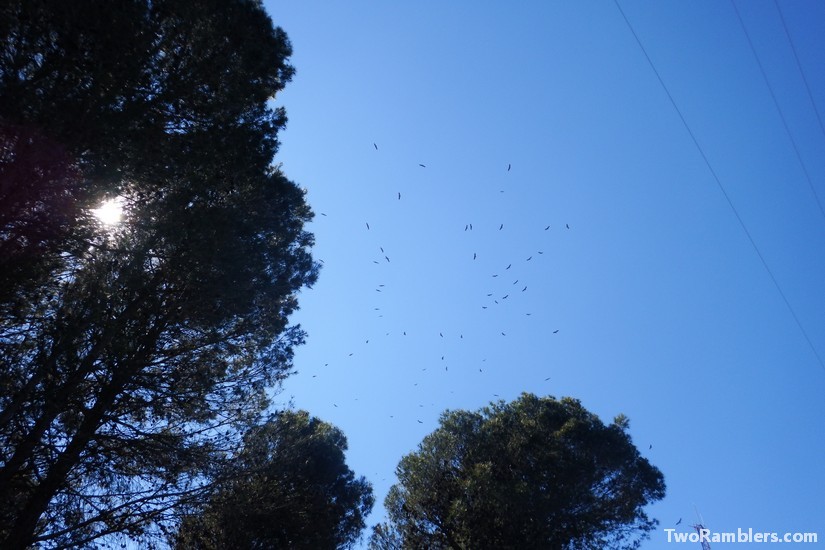
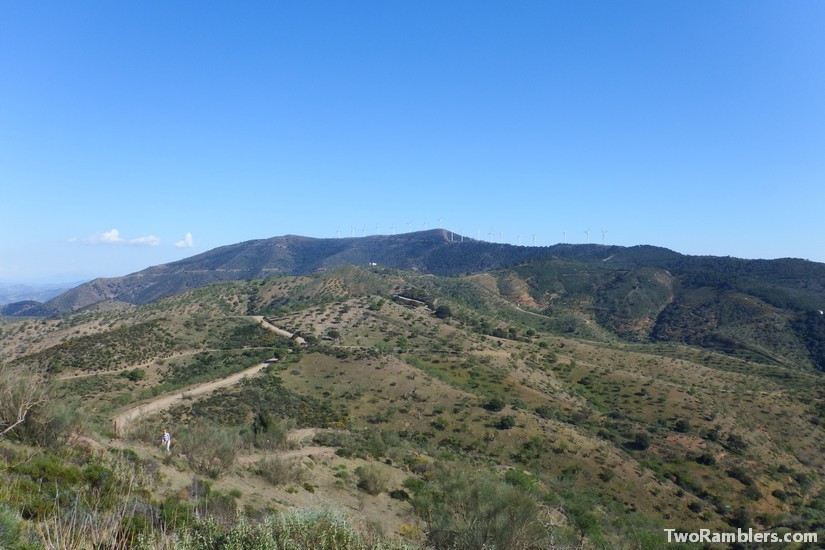
The pine trees were full of processionary caterpillars. Some were in the trees in hairy nests, others in long lines on the ground. Our worry of painful skin contact made us pick up the pace. We soon reached the last part of the hike which led through an enjoyable mixed forest on sandy paths in the shade. We descended into Carratraca and checked into a very cosy hotel. Our hosts offered us a delicious local dinner and we got a good night’s sleep.
Day 8: Carratraca to El Burgo – lemons, oranges, avocados and almonds
The following day, we left very early wanting to get a good part of the hike behind us before the sun would hit us with its full force. Leaving Carratraca we passed along orchards of lemons, oranges, avocados and almonds, many guarded by intimidating dogs. We were happy to have our walking sticks with us.
The road changed into a forest track with alternately pine trees and cork oaks. We crossed a small mountain range and had nice views on the surrounding hills. We could clearly see the difference between the hillsides on the north with green grass and lush trees and the ones on the south which were dry and sandy. Our route continued on a road offering a beautiful view of overhanging cliffs in front of us. As the road stopped, we continued first on a small path that became less and less visible. Luckily, there were some cairns we could follow. We went through bushes and had to cross a freshly ploughed field. After passing the highest point of this day, we soon were on a dirt road that let us through orchards into El Burgo. We arrived a little sunburned but thanks to a cooler wind we were less exhausted than the previous day.
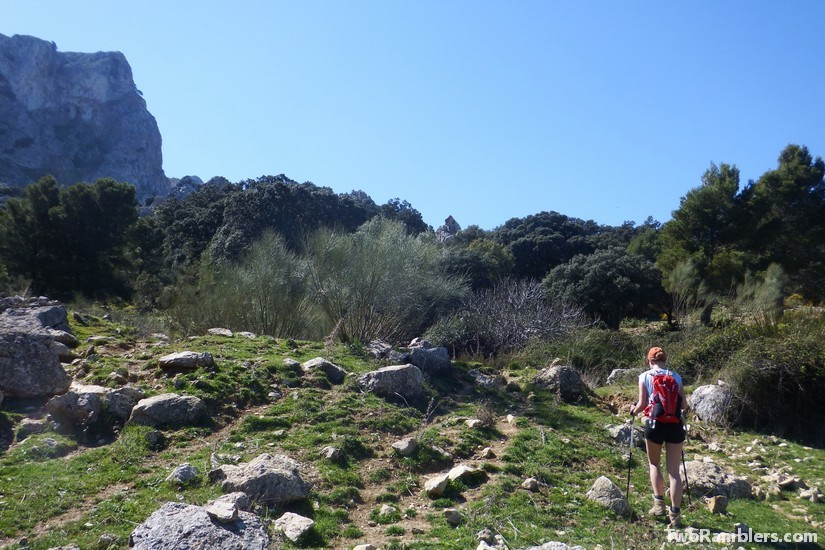
Day 9: El Burgo to Ronda – Nordic walkers and sheep
Again, we got an early start, knowing that 26 km were lying ahead of us. We entered Parque Natural Sierra de las Nieves following the Río Turón and its beautiful valley. For once, were not alone: many local women were out and about for some brisk walking. A winding path led us along the Río Turón valley for a good two hours, then passing an old dam. The route continued into the dry river bed and then back up, out of the valley onto a plateau. Up there, we had a great view over the river and valley behind us and the Torre de Lifa – the stone ruin of a tower – in front of us.
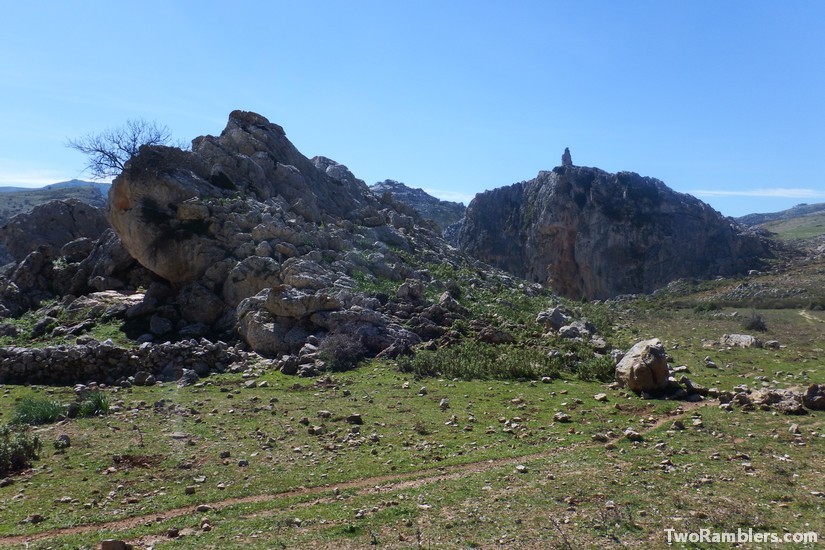
We passed a couple of sheep farms. Then we got onto a dirt road passing Puerto de Lifa and its abundant signs informing us that we were passing a nature park. As we slowly descended into the direction of Ronda, the town coming into view in front of us, the sun was burning down.
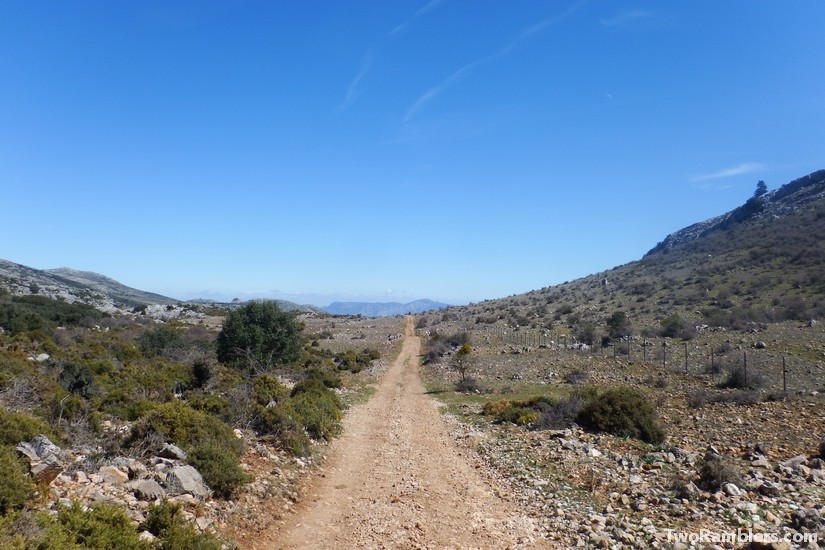
The descent was first still pleasant through the nature park. But it continued on an asphalt road leading straight to Ronda with nothing but dry fields around us. Finally, back in Ronda, we took a little rest out of the sun. Then we headed to the bus stop to take the first bus back to Málaga. Kevin enjoyed the last views over Andalucía from the winding roads. Franziska quickly fell asleep, exhausted from the walk under the heat.
Travel tips
This is for you if you are not into multi-day trekking but want to do some hiking in Andalucia and see the nature described in this post. We recommend the Sendero de la Mariposa Monarca (which we walked on our first day) and its surroundings as a day hike. Here you can find some useful photos and information about the route.
